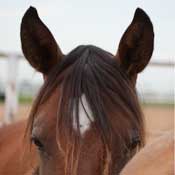|
The Ears Have ItBy Kenton H. Arnold, DVM
Putting on a headstall or taking off a halter are two simple maneuvers that we perform with our horses on a daily basis. These actions take no more of a conscious effort than donning a hat on the way out the door. However, once you encountered the horse with a sensitive ear you will never again take these simple tasks for granted. A painful ear can cause problems ranging from poor performance to a horse that is down right dangerous. Horses with ear problems quickly become problem horses that leave the owner and/or trainer frustrated and the horse miserable. It is amazing how often no significant effort is made to find and treat the underlying cause. All too often, the problem is blamed on someone who grabbed the ear for restraint in the past. This is a possibility, however, every effort should be made to determine the cause and correct the problem. Too often people assume that it is a past bad experience that created the problem, and never investigate other possibilities. The first and most important step is a thorough otic exam. Because of the sensitivity of the ear, heavy sedation will be required. The horse must be sedated enough to allow the visual inspection of the ear drum. This exam will be all that is necessary to identify problems such as ear ticks, foreign bodies or evidence of Otitis externa (infection of the ear canal). With most of these problems there will be a large amount of waxy buildup or other debris or exudate. Microscopic evaluation of the debris will identify the type of infection present. The most common infections occurring are parasitic (ticks or mites), bacterial, fungal, or yeast infections. Once is type of infection is identified, the proper medication can be utilized to clear the infection. The first step of treatment is to clean the ear, removing all the debris and the source of infection. This is best done by liberally flushing the ear with disinfectant solution. Proper flushing also requires heavy sedation and can be done after the exam, while the horse is still sedated. Avoid cleaning the ear with Q-tips as you may pack the debris further down the ear canal. After the flushing is complete, the appropriate medication can be applied. Subsequent treatments will likely be performed with the restraint provided by a twitch. Often, the medication will included a topical cortico steroid to decrease the pain and inflammation created from the infection. Some infections will require systemic antibiotics, especially if the ear drum is ruptured. The above procedures will eliminate the majority of "sensitive ear" problems and will make life much easier for both you and your horses. If the problem is not identified with an otic examination, at the very least several causes have been eliminated. Further diagnostic procedures are possible which can identify inner ear problems, tumors, tempomandibular joint problems... and the list can go on. On the list is the horse that just plain "doesn't like his ears messed with." It's best, however, to at least have a complete otic exam on a properly sedated horse. This will also allow the procedure to be performed safely and completely before that diagnosis decided on.
Equine Veterinary Services
|


©2024 Website Design and Photos by Jim Arnold,
Carroll Brown Arnold and Austria C. Arnold
